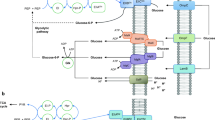Abstract
Fructose is toxic for Synechocystis PCC 6714 and 6803, strains which grow chemoheterotrophically on glucose. This toxicity, as well as fructose uptake, were inhibited by glucose or by its non-metabolized analogue 3-O-methyl-glucose. The results suggested that both sugars were transported by the same permeation system, the affinity for fructose, estimated from the corresponding K m and K i, being very low. The unicity of the permeation system was further established by the isolation of spontaneous mutants showing the expected pleiotropic phenotype, Glu−, Frur, transport−, and by the simultaneous re-acquisition of the relevant wild type characteristics in mutant cells transformed by wild type DNA. The genetic nature of this mutation is discussed in view of the impossibility to isolate spontaneously reversed wild type clones from the transport deficient mutants.
Similar content being viewed by others
Abbreviations
- OMG:
-
3-O-methyl-glucose
- DCMU:
-
3-(3,4 dichlorophenyl)-1,1-dimethylurea
References
Alam J, Curtis SE (1985) Characterization of a family of putative insertion elements from the cyanobacterium Anabaena. First Intern Congress of Plant Molecular Biology. Savannah, USA, pp 49
Abstier C (1976) Contribution à l'étude génétique d'une algue bleue Aphanocapsa 6714. Ph. D. Thesis. University Paris XI, France
Astier C, Joset-Espardellier F, Meyer I (1979) Conditions for mutagenesis in the cyanobacterium Aphanocapsa 6714. Arch Microbiol 120:93–96
Beauclerck AD, Smith AJ (1978) Transport of d-glucose and 3-O-methylglucose in the cyanobacteria Aphanocapsa 6714 and Nostoc Mac. Eur J Biochem 82:187–197
Buchou T (1979) Toxicité et transport du d-fructose chez une algue bleue, Aphanocapsa 6714. M. Sc. University Paris XI, France
Damerval T, Franche C, Rippka R, Cohen-Bazire G (1985) O2 dependence of nif gene rearrangement in a Het mutant of Nostoc. In: Proceedings of the Vth Intern. Symp. on Photosynthetic Prokaryotes. Grindelwald, Switzerland, p 123
Der Vartanian M, Joset-Espardellier F, Astier C (1981) Contributions of respiratory and photosynthetic pathways during growth of a facultative photoautotrophic cyanobacterium, Aphanocapsa 6714. Plant Physiol 168:974–978
Ferenci T, Kornberg HL (1973) The utilization of fructose by Escherichia coli. Properties of a mutant defective in fructose-1-phosphate kinase activity. J Biochem 132:341–347
Flores E, Schmetterer G (1986) Interaction of fructose with the glucose permease of the cyanobacterium Synechocystis sp. strain PCC 6803. J Bacteriol 166:693–696
Golden JW, Robinson SJ, Haselkorn R (1985) Rearrangement of nitrogen fixation genes during heterocyst differentiation in the cyanobacterium Anabeana. Nature 314:419–423
Huber SC (1986) Fructose-di-phosphate as a regulatory metabolite in plants. Ann Rev Plant Physiol 37:233–376
Joset-Espardellier F, Astier C, Evans EH, Carr NG (1978) Cyanobacteria grown under photoautotrophic, photoheterotrophic, and heterotrophic regimes: sugar metabolism and carbon dioxide fixation. FEMS Microbiol Letters 4:261–264
Karni L, Tel-Or E (1985) N2 fixation enhancement in vivo by Krebs cycle intermediates and by sugars in the cyanobacterium Nostoc muscorum. In: Proceedings of the Vth Intern. Symp. on Photosynthetic Prokaryotes. Grindelwald, Switzerland, p 60
Mazel D, Houmard J, Castets A-M, Tandeau DE, Marsac N (1986) Séquences d'ADN mobiles altérant l'expression des gènes des phycobiliprotéines chez Calothrix 7601. In: Journée d'étude sur les potentialités biologiques des Cyanobactéries. Paris, France
Pelroy RA, Rippka R, Stanier RY (1972) Metabolism of glucose by unicellular blue-green algae. Arch Mikrobiol 87:303–322
Raboy B, Padan E (1978) Active transport of glucose and α-methylglucoside in the cyanobacterium Plectonema boryanum. J. Biol Chem 253:3287–3291
Rebière M-C (1983) Recherche de moyens d'analyse génétique pour l'étude de l'organisation des gènes correspondant aux phycobiliprotéines chez les cyanobactéries. Ph. D. Thesis, University Paris VII, France
Rippka R, Deruelle J, Waterbury JB, Herdman M, Stanier RY (1979) Generic assignments, strain histories and properties of pure cultures of cyanobacteria. J Gen Microbiol 111:1–61
Rosen A, Arad H, Tel-Or E (1985) Fructose-dependent differentiation, N2 fixation and growth in the cyanobacterium Anabaena azollae. In: Proceedings on the Vth Intern. Symp. on Photosynthetic Prokaryotes. Grindelwald, Switzerland, p 258
Author information
Authors and Affiliations
Rights and permissions
About this article
Cite this article
Joset, F., Buchou, T., Zhang, CC. et al. Physiological and genetic analysis of the glucose-fructose permeation system in two Synechocystis species. Arch. Microbiol. 149, 417–421 (1988). https://doi.org/10.1007/BF00425581
Received:
Accepted:
Issue Date:
DOI: https://doi.org/10.1007/BF00425581




